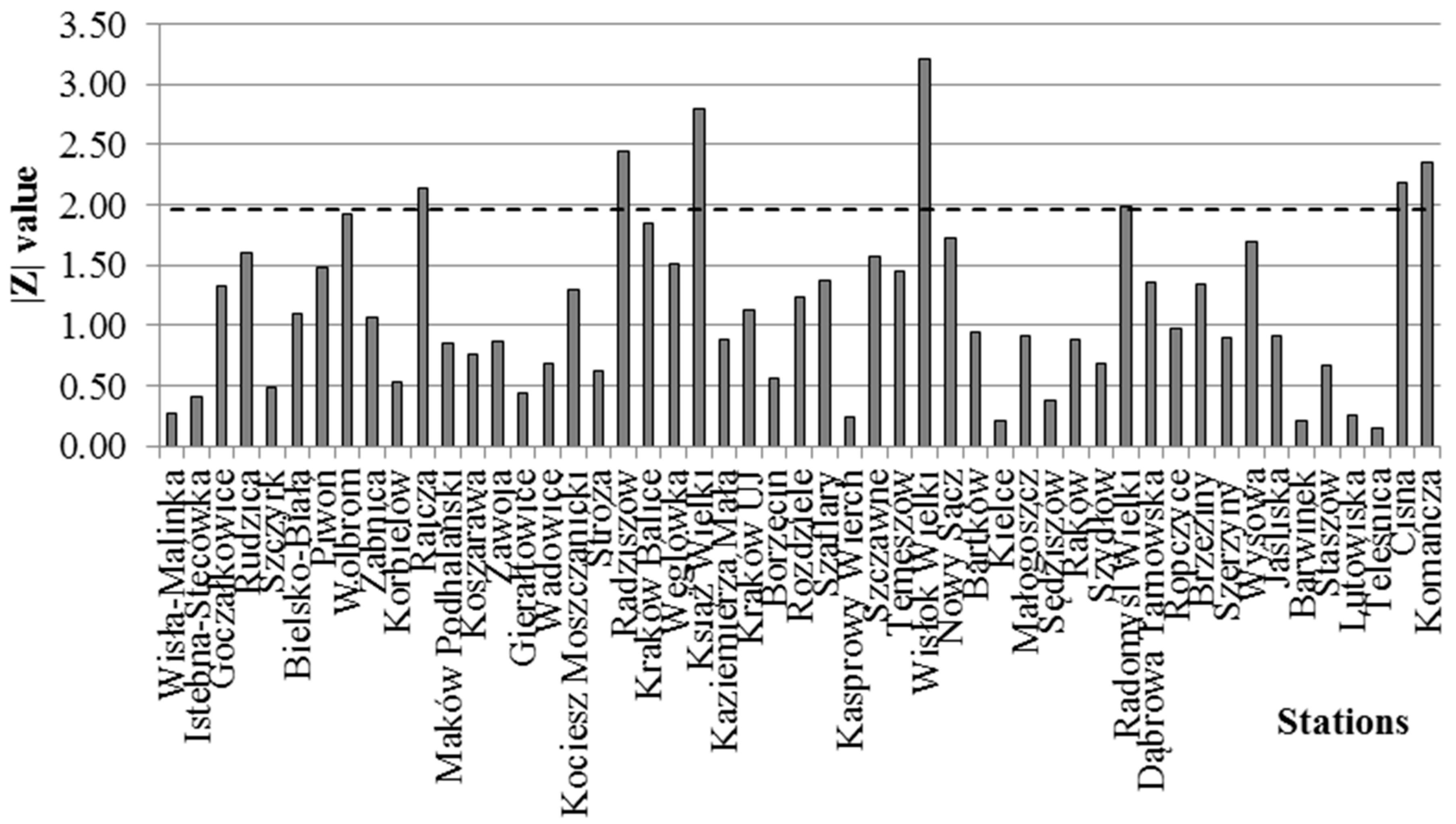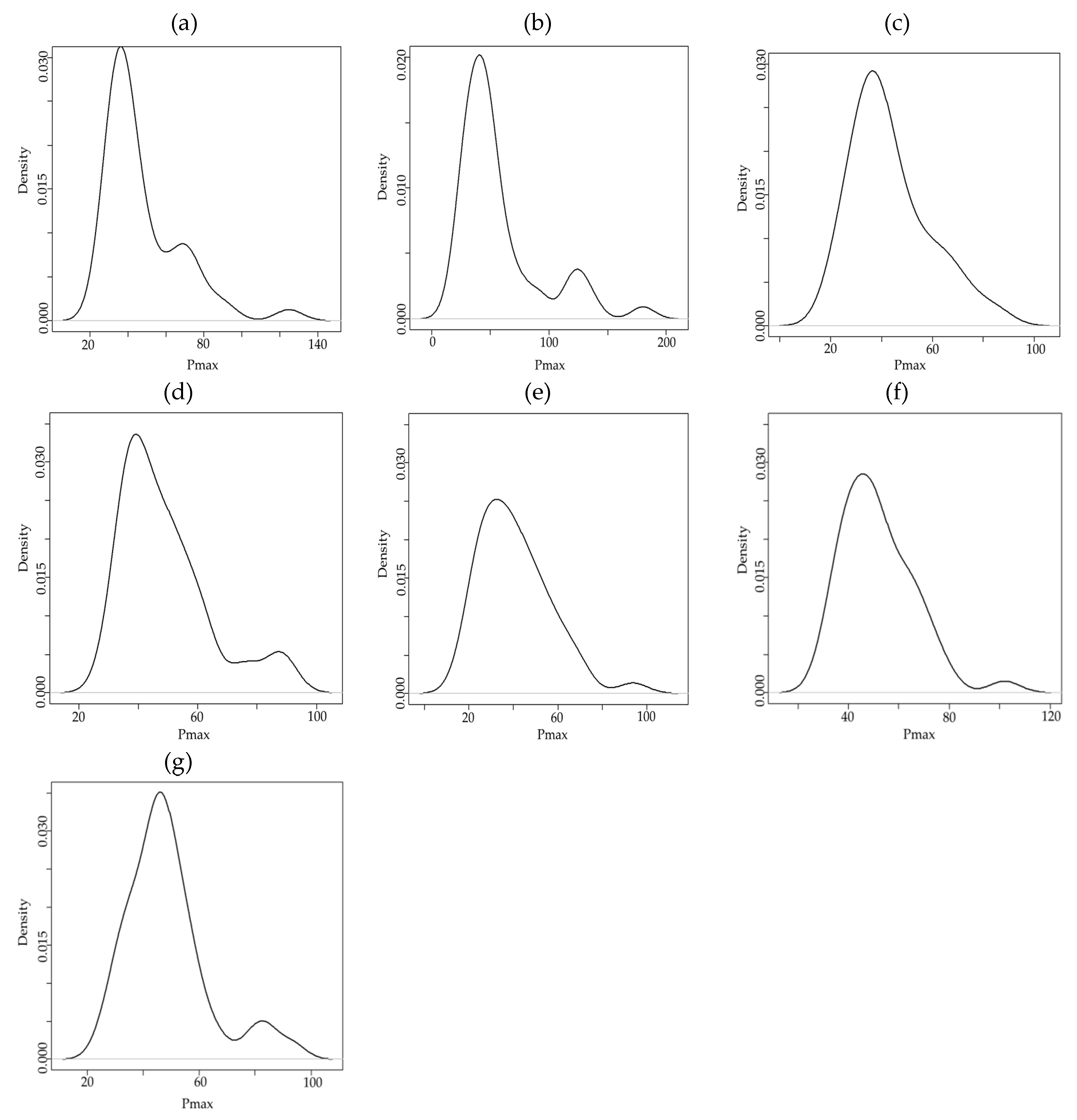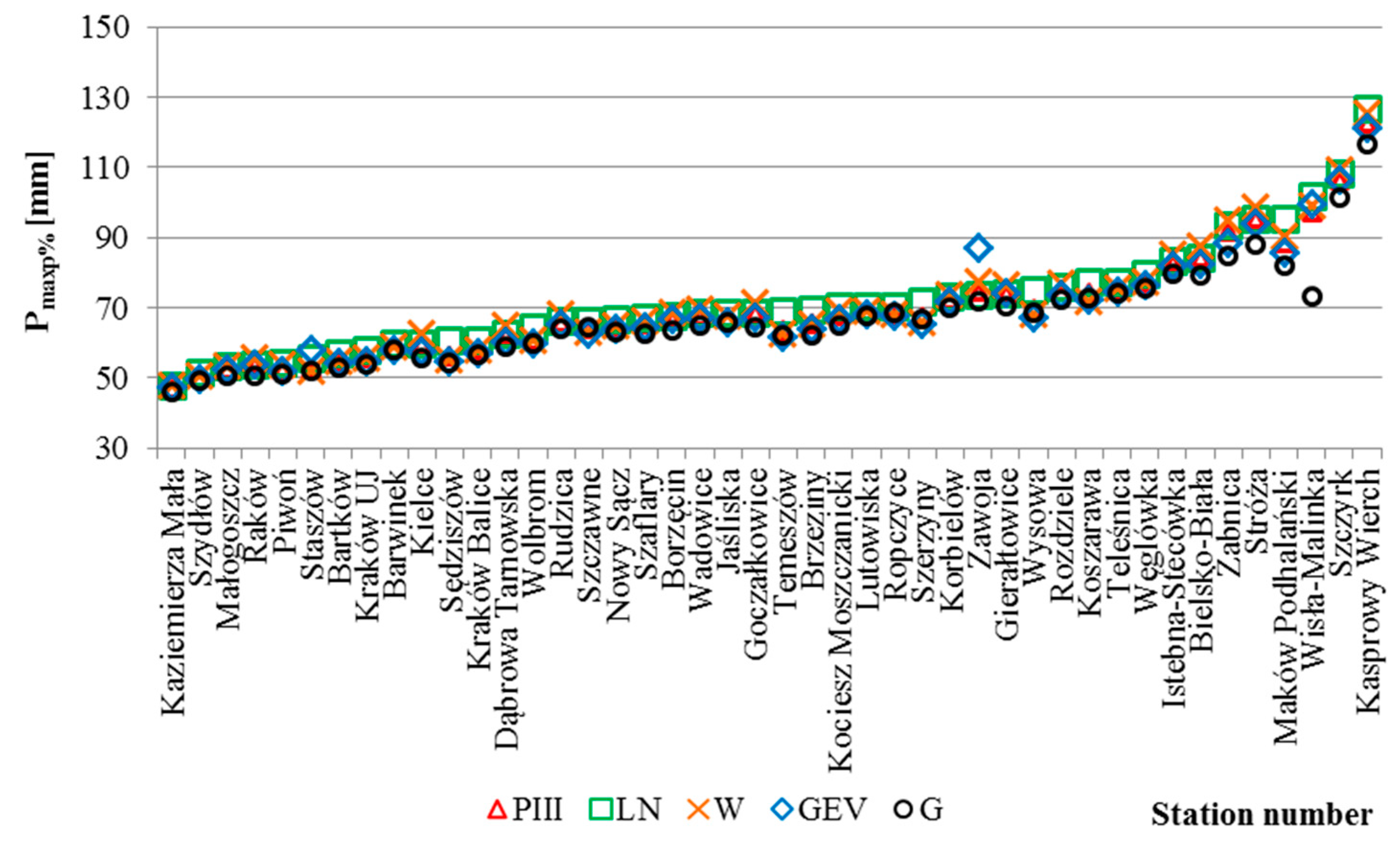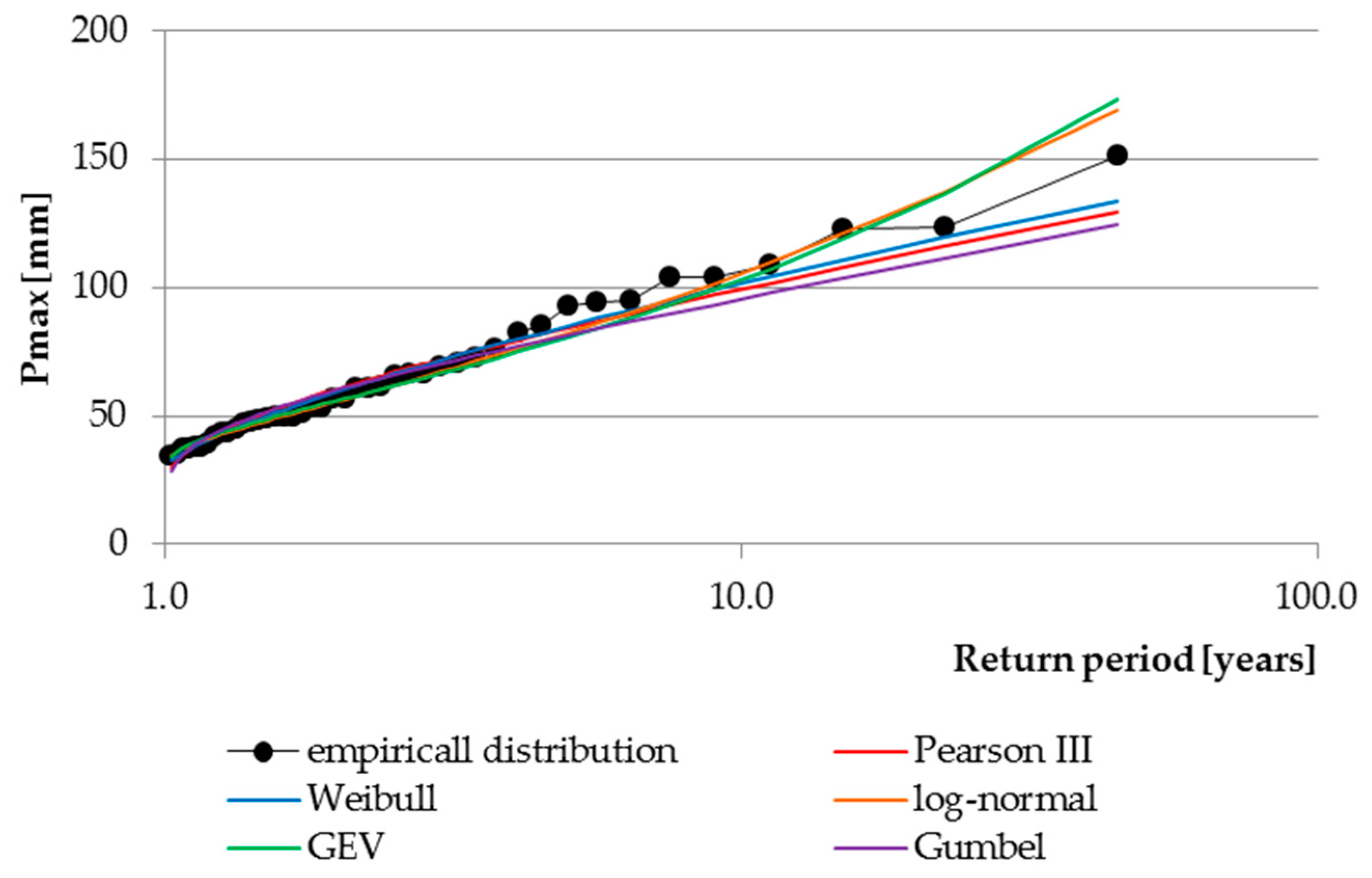Estimating Maximum Daily Precipitation in the Upper Vistula Basin, Poland
Abstract
1. Introduction
2. Description of the Study Area
3. Methods
3.1. Preliminary Analysis of the Observation Series
3.2. Analysis of Trends in the Observed Series
- n—the number of elements of the time series,
- xj—observation at time j,
- xk—observation at time k.
- n—the number of elements of the time series.
- —the effective number of observations calculated as:
- ρk—the lag k autocorrelation coefficients of the ranks of the observations.
3.3. Identification of Empirical Distributions with Kernel Estimators
- n—sample size;
- h—smoothing parameter equated with so-called band width;
- K—kernel function;
- Xi—i-th element of the sample.
3.4. Maximum Annual Daily Precipitation with a Specific Probability of Exceedance
- κ, λ, β—shape parameters;
- t(λ)—standardized variable;
- α—scale parameter;
- ε, ξ—location parameter;
- μ, σ—parameters of log-normal;
- p—probability of exceedance;
- up—the standard normal variate of probability of exceedance p.
3.5. Selection of the Theoretical Function Best Fitting The Empirical Distribution and Sensitivity to Outliers
- n—size of the observation series;
- ei—difference between the observed and estimated value of the maximum daily precipitation for year i;
- Oi—observed values for year i;
- Pi—predicted values for year i;
- —mean of observed values;
- —mean of predicted values.
4. Results and Discussion
4.1. Preliminary Analysis of the Annual Maximum Precipitation
4.2. Analysis of Trends in the Observed Series
4.3. Identification of Empirical Distributions with Kernel Estimators
4.4. Determination of the Maximum Annual Daily Precipitation with Specific Probability of Exceedance
4.5. Selection of the Best Fit between the Theoretical and Empirical Distribution of Random Variables
5. Conclusions
Author Contributions
Acknowledgments
Conflicts of Interest
References
- Schmocker-Fackel, P.; Naef, F. More frequent flooding? Changes in flood frequency in Swicerland since 1850. J. Hydrol. 2010, 381, 1–8. [Google Scholar] [CrossRef]
- Wałęga, A.; Kaczor, G.; Stęplewski, B. The Role of Local Precipitation Models in Designing Rainwater Drainage Systems in Urban Areas: A Case Study in Krakow, Poland. Pol. J. Environ. Stud. 2016, 25, 2139–2149. [Google Scholar] [CrossRef]
- Chmielowski, K.; Bugajski, P.M.; Kaczor, G. Effects of precipitation on the amount and quality of raw sewage entering a sewage treatment plant in Wodzisław Śląski. J. Water Land Dev. 2017, 34, 85–93. [Google Scholar] [CrossRef]
- Coumou, D.; Rahmstorf, S.A. decade of weather extremes. Nat. Clim. Chang. 2012, 2, 491–496. [Google Scholar] [CrossRef]
- Min, K.S.; Zhang, X.; Zwiers, F.W.; Hegerl, G.C. Human contribution to more-intense precipitation extremes. Nature 2011, 470, 378–381. [Google Scholar] [CrossRef] [PubMed]
- Tye, M.R.; Colley, D. A spatial model to examine rainfall extremes in Colorado’s Front Range. J. Hydrol. 2015, 530, 15–23. [Google Scholar] [CrossRef]
- Singh, B.; Rajpurohit, D.; Vasishth, A.; Singh, J. Probability analysis for estimation of annual one day maximum rainfall of Jhalarapatan Area of Rajasthan. India Plant Arch. 2012, 12, 1093–1100. [Google Scholar]
- Papalexiou, S.M.; Koutsoyiannis, D.; Makropoulos, C. How extreme is extreme. An assessment of daily distribution tails. Hydrol. Earth Syst. Sci. 2013, 17, 851–862. [Google Scholar] [CrossRef]
- Salinas, J.L.; Castellarin, A.; Kohnová, S.; Kjeldsen, T.R. Regional parent flood frequency distributions in Europe—Part 2: Climate and scale controls. Hydrol. Earth Syst. Sci. 2014, 18, 4391–4401. [Google Scholar] [CrossRef]
- Amin, M.T.; Rizwan, M.; Alazba, A.A. Abest fit probability distribution for the estimation of rainfall in northen regions of Pakistan. Open Life Sci. 2016, 11, 432–440. [Google Scholar]
- Sun, H.; Wang, G.; Li, X.; Chen, J.; Su, B.; Jiang, T. Regional frequency analysis of observed sub-daily rainfall maxima over eastern China. Adv. Atmos. Sci. 2017, 34, 209–225. [Google Scholar] [CrossRef]
- Douka, M.; Karacostas, T.S.; Katragkou, E.; Anagnostolpoulou, C. Annual and seasonal extreme precipitation probability distributions at Thessaloniki based upon hourly values. In Perspectives on Atmospheric Sciences; Karacostas, T., Bais, A., Nastos, P., Eds.; Springer Atmospheric Sciences; Springer: Cham, Switzerland, 2017. [Google Scholar]
- Boudrissa, N.; Cheraitia, H.; Haliami, L. Modelling maximum daily yearly rainfall in northern Algeria using generalized extreme value distributions from 1936 to 2009. Meteorol. Appl. 2017, 24, 114–119. [Google Scholar] [CrossRef]
- Wdowikowski, M.; Kaźmierczak, B.; Levinka, O. Maximum daily rainfall analysis at selected meteorological stations in the upper Lusatian Neisse River basin. Meteorol. Hydrol. Water Manag. 2016, 4, 53–63. [Google Scholar] [CrossRef]
- Koutsoyiannis, D. Statistics of extremes and estimation of extreme rainfall: I. Theoretical investigation. Hydrol. Sci. J. 2004, 49, 575–590. [Google Scholar] [CrossRef]
- Koutsoyiannis, D. Statistics of extremes and estimation of extreme rainfall: II. Empirical investigation of long rainfall records. Hydrol. Sci. J. 2004, 49, 591–610. [Google Scholar] [CrossRef]
- Haddad, K.; Rahman, A. Selection of the best fit flood frequency distribution and parameter estimation procedure: A case study for Tasmania in Australia. Stoch. Environ. Res. Risk Assess. 2011, 25, 415–428. [Google Scholar] [CrossRef]
- Laio, F.; Di Baldassarre, G.; Montanari, A. Model selection techniques for the frequency analysis of hydrological extremes. Water Resour. Res. 2008, 45. [Google Scholar] [CrossRef]
- Sun, X.; Lall, U. Spatially coherent trends of annual maximum daily precipitation in the United States. Geophys. Res. Lett. 2015, 42, 9781–9789. [Google Scholar] [CrossRef]
- Delignette-Muller, M.L.; Dutang, C. An R Package for fitting distributions. J. Stat. Softw. 2015, 64, 1–34. [Google Scholar] [CrossRef]
- Wałęga, A. The importance of the objective functions and flexibility on calibration of parameters of Clark instantaneous unit hydrograph. Geomat. Landmanag. Landsc. 2014, 2, 75–85. [Google Scholar] [CrossRef]
- Wałęga, A.; Książek, L. Influence of rainfall data on the uncertainty of flood simulation. Soil Water Res. 2016, 11, 277–284. [Google Scholar] [CrossRef]
- Wałęga, A.; Młyński, D.; Bogdał, A.; Kowalik, T. Analysis of the course and frequency of high water stages in selected catchments of the Upper Vistula basin in the south of Poland. Water 2016, 8, 394. [Google Scholar] [CrossRef]
- Wałęga, A.; Młyński, D.; Wachulec, K. The use of the asymptotic functions for determing empirical values of CN parameter in selected catchments of variable land cover. Studia Geotechnica et Mechanica 2018, 39, 111–120. [Google Scholar] [CrossRef]
- Amirataee, B.; Montaseri, M.; Rezaei, H. Assessment of goodness of fit methods in determing the best regional probability distribution of rainfall data. Int. J. Eng. 2014, 27, 1537–1546. [Google Scholar]
- Ba, I.; Ashkar, F. Discrimination between a group of three-parameter distributions for hydro-meteorological frequency modeling. Can. J. Civ. Eng. 2018, 45, 351–365. [Google Scholar] [CrossRef]
- Hinkle, D.E.; Wiersma, W.; Jurs, S.G. Applied Statistics for the Behavioral Sciences; Houghton Mifflin: Boston, MA, USA, 2003. [Google Scholar]
- Alam, M.A.; Emuro, K.; Farnham, C.; Yuan, J. Best-fit probability distributions and return periods for maximum monthly rainfall in Bangladesh. Climate 2018, 6, 9. [Google Scholar] [CrossRef]
- Kumar, A. Prediction of annual maximum daily rainfall of Ranichauri (Tehri Garhwal) based on probability analysis. Ind. J. Soil Conserv. 2000, 28, 178–180. [Google Scholar]
- Lee, C. Application of rainfall frequency analysis on studying rainfall distribution characteristics of Chia-Nan plain area in Southern Taiwan. Crop Environ. Bioinf. 2005, 2, 31–38. [Google Scholar]
- Kundzewicz, Z.W.; Stoffel, M.; Niedźwiedź, T.; Wyżga, B. Flood Risk in the Upper Vistula Basin; Springer: Cham, Switzerland, 2016. [Google Scholar]
- Tabari, H.; Marofi, S.; Aeini, A.; Talaee, P.H.; Mohammadi, K. Trend analysis of reference evapotranspiration in the western half of Iran. Agric. For. Meteorol. 2011, 151, 128–136. [Google Scholar] [CrossRef]
- Rutkowska, A.; Ptak, M. On certain stationary tests for hydrological series. Studia Geotechnica et Mechanica 2012, 4, 51–63. [Google Scholar] [CrossRef]
- Banasik, K.; Hejduk, L. Long term changes in runoff from a small agricultural catchment. Soil Water Res. 2012, 7, 64–72. [Google Scholar] [CrossRef]
- Jeneiová, K.; Kohnová, S.; Sabo, M. Detecting trends in the annual maximum discharges in the Vah River Basin, Slovakia. Acta Silv. Lign. Hung. 2014, 10, 133–144. [Google Scholar] [CrossRef]
- Blain, G.C. The influence of nonlinear trends on the power of the trend-free pre-whitening approach. Acta Scientarum Agron. 2015, 37, 21–28. [Google Scholar] [CrossRef]
- Mann, H.B. Non-parametric tests against trend. Econometrica 1945, 13, 245–259. [Google Scholar] [CrossRef]
- Kendall, M.G. Rank Correlation Methods; Charles Griffin: London, UK, 1975. [Google Scholar]
- Hamed, K.H.; Rahman, A. A modified Mann-Kendall trend test for autocorrelated data. J. Hydrol. 1998, 204, 219–246. [Google Scholar] [CrossRef]
- Haghighatjou, P.; Akhoond-Ali, A.M.; Nazemosadat, M.J. Nonparametric kernel estimation of annual precipitation over Iran. Theor. Appl. Climatol. 2013, 112, 193–200. [Google Scholar] [CrossRef]
- Krakauer, N.Y.; Pradhanang, S.M.; Panthi, J.; Lakhankar, T.; Jha, A.J. Probabilistic precipitation estimation with a satellite product. Climate 2015, 3, 329–348. [Google Scholar] [CrossRef]
- Mosthaf, T.; Bárdossy, A. Regionalizing nonparametric models of precipitation amounts on different temporal scales. Hydrol. Earth Syst. Sci. 2017, 21, 2463–2481. [Google Scholar] [CrossRef]
- Peng, J.; Zhao, S.; Liu, X.; Tian, L. Identifying the urban-rural fringe using wavelet transform and kernel density estimation: A case study in Beijing City, China. Environ. Model. Softw. 2016, 83, 286–302. [Google Scholar] [CrossRef]
- Pathiraja, S.; Moradkhani, H.; Marshall, L.; Sharma, A.; Geenens, G. Data-driven model uncertainty estimation in hydrologic data assimilation. Water Resour. Res. 2018, 54, 1252–1280. [Google Scholar] [CrossRef]
- Silverman, B.W. Density Estimation for Statistics and Data Analysis; Chapman and Hall: London, UK, 1986. [Google Scholar]
- Sivakumar, B. Chaos in Hydrology: Bridging Determinism and Stochasticity; Springer: Sidney, BC, Canada, 2016. [Google Scholar]
- Węglarczyk, S. Statistics in Environmental Engineering; Cracow University of Technology Publishing House: Kraków, Poland, 2010. (In Polish) [Google Scholar]
- Młyński, D. Analysis of the form of probability distribution to calculate flood frequency in selected mountain river. Episteme 2016, 1, 399–411. (In Polish) [Google Scholar]
- Strupczewski, W.G.; Singh, V.P.; Węglarczyk, S. Asymptotic bias of estimation methods caused by the assumption of false probability distribution. J. Hydrol. 2002, 258, 122–148. [Google Scholar] [CrossRef]
- Strupczewski, W.G.; Kochanek, K.; Bogdanowicz, E.; Markiewicz, I. The accuracy of skewness coefficient and flood quantiles estimated by means of weighted function method for Pearson type 3 distribution function. In Hydrologia w i Inżynierii i Ochronie Środowiska; Więzik, W., Hejduk, L., Eds.; Publ. PAN: Warsaw, Poland, 2018. (In Polish) [Google Scholar]
- McNeil, A.J. Estimating the tail of loss severity distributing using extreme value theory. ASTIN Bull. 1997, 27, 117–137. [Google Scholar] [CrossRef]
- Degeling, K.; IJzerman, M.J.; Koopman, M.; Koffijberg, H. Accounting for parameter uncertainty in the definition of parametric distributions used to describe individual patient variation in health economic models. BMC Med. Res. Methodol. 2017, 17, 170. [Google Scholar] [CrossRef]
- Zeng, X.; Wang, D.; Wu, J. Comparisons of methods of goodness of fit tests in hydrologic analysis. In Emerging, Economies, Risk and Development and Intelligent Technology; Huang, C., Lyhyaoui, A., Zhai, G., Benhayoun, N., Eds.; Taylor: London, UK, 2015. [Google Scholar]
- Krause, P.; Boyle, D.P.; Base, F. Comparrison of different efficiency criteria for hydrological model assessment. Adv. Geosci. 2005, 5, 89–97. [Google Scholar] [CrossRef]
- Chai, T.; Draxler, R.R. Root mean square error (RMSE) or mean absolute error (MAE)?—Arguments against avoiding RMSE in the literature. Geosci. Model Dev. 2014, 7, 1247–1250. [Google Scholar] [CrossRef]
- Bezak, N.; Brilly, M.; Šraj, M. Flood frequency analyses, statistical trends and seasonality analyses of discharge data: A case study of the Litija station on the Sava River. Flood Risk Manag. 2016, 9, 154–168. [Google Scholar] [CrossRef]
- Wałęga, A. The importance of calibration parameters on the accuracy of the floods description in the Snyder’s model. J. Water Land Dev. 2016, 28, 19–25. [Google Scholar] [CrossRef]
- Cebulska, M.; Twardosz, R. Temporal variability of maximum monthly precipitation totals in the Polish Western Carpathian Mts during the period 1951–2005. Prace Geograficzne 2012, 128, 123–134. (In Polish) [Google Scholar]
- Niedźwiedź, T.; Łupikasza, E.; Pińskwar, I.; Kundzewicz, Z.W.; Stoffel, M.; Małarzewski, Ł. Climatological background of floods at the northern foothills of the Tatra Mountains. Theor. Appl. Climatol. 2014, 119, 273–284. [Google Scholar] [CrossRef]
- Młyński, D.; Petroselli, A.; Wałęga, A. Flood frequency analysis by an event-based rainfall-runoff model in selected catchments of southern Poland. Soil Water Res. 2018, 13, 170–176. [Google Scholar]
- Kundzewicz, Z.W.; Pińskwar, I.; Choryński, A.; Wyżga, B. Floods still pose a hazard. Aura 2017, 3, 3–9. (In Polish) [Google Scholar]
- Buchert, L.; Cebulak, L.; Drwal-Tylmann, A.; Wojtczak-Gaglik, E.; Kilar, P.; Limanówka, D.; Łapińska, E.; Mizera, M.; Ogórek, S.; Pryc, P.; et al. Dangerous Meteorological Phenomenas—Part 1 (Spring–Summer); Instytut Meteorologii i Gospodarki Wodnej Państwowy Instytut Badawczy: Warszawa, Poland, 2013. (In Polish) [Google Scholar]
- Młyński, D.; Cebulska, M.; Wałęga, A. Trends, variability, and seasonality of maximum annual daily precipitation in the upper Vistula basin, Poland. Atmosphere 2018, 9, 313. [Google Scholar] [CrossRef]
- Kochanek, K.; Feluch, W. The estimation of flood quantiles of selected heavy-tailed distribution by means of the method of the generalized moments. Przegląd Geofizyczny 2016, 3–4, 171–172. (In Polish) [Google Scholar]
- Cebulska, M. The long-term variability of maximum daily precipitations in the Kotlina Orawsko-Nowotarska (Orawa-Nowy Targ Valley) (1984–2013). Czasopismo Inżynierii Lądowej Środowiska i Architektury 2015, 32, 49–60. (In Polish) [Google Scholar]
- Krężałek, K.; Szymczak, T.; Bąk, B. The annual maximum daily rainfall with different probabilities of exceedance in central Poland based on data from the multiannual period 1966–2010. Woda-Środowisko-Obszary Wiejskie 2013, 13, 77–90. (In Polish) [Google Scholar]
- Villarini, G. Analyses of annual and seasonal maximum daily rainfall accumulations for Ukraine, Moldova, and Romania. Int. J. Climatol. 2012, 32, 2213–2226. [Google Scholar] [CrossRef]







| Station | LPmax | MPmax | HPmax | s | Cs | A |
|---|---|---|---|---|---|---|
| mm | mm | mm | mm | - | - | |
| Wisła-Malinka | 34.5 | 64.8 | 151.4 | 27.2 | 0.42 | 1.3 |
| Istebna-Stecówka | 26.9 | 56.9 | 133.6 | 22.2 | 0.39 | 1.6 |
| Goczałkowice | 23.0 | 45.4 | 149.7 | 22.6 | 0.50 | 2.7 |
| Rudzica | 21.7 | 47.4 | 108.7 | 16.1 | 0.34 | 1.8 |
| Szczyrk | 36.3 | 70.3 | 213.0 | 32.3 | 0.46 | 2.3 |
| Bielsko-Biała | 24.9 | 55.5 | 162.7 | 26.7 | 0.48 | 2.4 |
| Piwoń | 17.5 | 36.9 | 96.8 | 13.3 | 0.36 | 2.2 |
| Wolbrom | 18.6 | 41.3 | 82.3 | 14.8 | 0.36 | 0.9 |
| Żabnica | 22.5 | 57.8 | 192.0 | 31.8 | 0.55 | 2.4 |
| Korbielów | 29.7 | 52.2 | 106.1 | 17.0 | 0.33 | 1.4 |
| Rajcza | 27.7 | 47.9 | 124.8 | 19.8 | 0.41 | 1.8 |
| Maków Podhalański | 21.0 | 54.5 | 190.8 | 30.2 | 0.55 | 2.4 |
| Koszarawa | 30.3 | 52.5 | 90.6 | 15.9 | 0.30 | 0.6 |
| Zawoja | 28.8 | 58.1 | 138.0 | 24.1 | 0.42 | 1.5 |
| Gierałtowice | 26.9 | 50.1 | 133.4 | 21.4 | 0.43 | 2.0 |
| Wadowice | 24.0 | 46.7 | 118.4 | 18.3 | 0.39 | 1.8 |
| Kocierz Moszczanicki | 19.9 | 57.0 | 180.4 | 34.9 | 0.61 | 1.8 |
| Stróża | 22.4 | 46.3 | 129.5 | 18.4 | 0.40 | 2.3 |
| Radziszów | 20.7 | 42.9 | 82.4 | 15.1 | 0.35 | 1.1 |
| Kraków Balice | 17.8 | 40.0 | 87.4 | 13.9 | 0.35 | 1.0 |
| Węglówka | 24.9 | 53.6 | 112.1 | 18.4 | 0.34 | 1.1 |
| Książ Wielki | 19.4 | 43.4 | 86.4 | 15.4 | 0.35 | 0.9 |
| Kazimierza Mała | 21.0 | 34.3 | 71.1 | 10.7 | 0.31 | 1.2 |
| Kraków UJ | 17.5 | 39.0 | 79.0 | 14.8 | 0.38 | 1.0 |
| Borzęcin | 20.6 | 43.6 | 125.2 | 20.4 | 0.47 | 1.9 |
| Rozdziele | 21.2 | 50.4 | 126.1 | 20.6 | 0.41 | 2.0 |
| Szaflary | 23.2 | 45.3 | 103.2 | 17.0 | 0.38 | 1.7 |
| Kasprowy Wierch | 36.4 | 81.2 | 232.0 | 36.6 | 0.45 | 1.9 |
| Szczawne | 26.2 | 47.7 | 77.8 | 12.0 | 0.25 | 0.4 |
| Temeszów | 21.3 | 44.8 | 88.5 | 14.0 | 0.31 | 1.1 |
| Wisłok Wielki | 29.3 | 48.9 | 89.7 | 15.0 | 0.31 | 1.3 |
| Nowy Sącz | 25.4 | 45.7 | 82.6 | 14.8 | 0.32 | 0.9 |
| Bartków | 17.6 | 37.0 | 70.3 | 13.5 | 0.37 | 0.8 |
| Kielce | 17.0 | 38.9 | 155.2 | 21.4 | 0.55 | 3.8 |
| Małogoszcz | 19.0 | 36.8 | 80.4 | 13.4 | 0.36 | 1.5 |
| Sędziszów | 16.6 | 37.7 | 75.3 | 13.8 | 0.37 | 0.8 |
| Raków | 19.6 | 36.1 | 114.2 | 16.5 | 0.46 | 2.6 |
| Szydłów | 18.8 | 35.8 | 79.5 | 11.8 | 0.33 | 1.3 |
| Radomyśl Wielki | 17.8 | 40.5 | 93.9 | 15.7 | 0.39 | 1.1 |
| Dąbrowa Tarnowska | 23.1 | 43.3 | 152.7 | 19.1 | 0.44 | 4.2 |
| Ropczyce | 21.6 | 49.0 | 98.4 | 14.9 | 0.30 | 0.9 |
| Brzeziny | 22.3 | 43.8 | 95.4 | 17.0 | 0.39 | 1.2 |
| Szerzyny | 28.5 | 49.1 | 85.2 | 13.1 | 0.27 | 0.4 |
| Wysowa | 21.9 | 48.2 | 84.5 | 15.1 | 0.31 | 0.5 |
| Jaśliska | 24.0 | 48.3 | 105.7 | 14.9 | 0.31 | 1.7 |
| Barwinek | 23.8 | 43.9 | 78.4 | 11.6 | 0.26 | 1.2 |
| Staszów | 18.3 | 36.3 | 71.6 | 11.9 | 0.33 | 0.7 |
| Lutowiska | 25.3 | 49.7 | 94.7 | 15.3 | 0.31 | 0.9 |
| Teleśnica | 21.0 | 52.0 | 111.3 | 18.7 | 0.36 | 0.9 |
| Cisna | 30.9 | 51.8 | 102.0 | 14.1 | 0.27 | 1.2 |
| Komańcza | 25.1 | 48.5 | 93.5 | 14.6 | 0.30 | 1.3 |
| Station Number | Station | The Best Adjusted Distribution (Goodness-of-Fit Measures Value) | ||
|---|---|---|---|---|
| PWRMSE | RMSE | R2 | ||
| 1 | Wisła-Malinka | W (5.307) | W (4.583) | W (0.985) |
| 2 | Istebna-Stecówka | LN (4.896) | LN (4.019) | GEV (0.985) |
| 3 | Goczałkowice | GEV (8.237) | GEV (5.799) | GEV (0.971) |
| 4 | Rudzica | GEV (8.237) | GEV (8.237) | GEV (0.943) |
| 5 | Szczyrk | GEV (8.135) | GEV (6.253) | GEV (0.972) |
| 6 | Bielsko-Biała | GEV (10.625) | GEV (7.826) | GEV (0.951) |
| 7 | Piwoń | LN (4.181) | LN (3.322) | LN (0.939) |
| 8 | Wolbrom | PIII (1.789) | PIII (1.700) | G (0.990) |
| 9 | Żabnica | GEV (9.718) | GEV (7.082) | GEV (0.970) |
| 10 | Korbielów | GEV (13.346) | GEV (11.562) | GEV (0.987) |
| 11 | Maków Podhalański | LN (6.391) | LN (5.189) | LN (0.973) |
| 12 | Koszarawa | PIII (2.301) | PIII (2.179) | GEV (0.985) |
| 13 | Zawoja | GEV (3.669) | GEV (3.258) | W (0.990) |
| 14 | Gierałtowice | GEV (3.769) | GEV (3.078) | GEV (0.991) |
| 15 | Wadowice | LN (4.635) | LN (3.836) | GEV (0.970) |
| 16 | Kociesz Moszczanicki | LN (5.155) | LN (4.078) | LN (0.952) |
| 17 | Stróża | LN (3.191) | LN (2.833) | LN (0.971) |
| 18 | Kraków Balice | PIII (2.807) | PIII (2.432) | GEV (0.977) |
| 19 | Węglówka | LN (1.942) | LN (1.879) | GEV (0.993) |
| 20 | Kaziemierza Mała | LN (1.367) | LN (1.210) | GEV (0.992) |
| 21 | Kraków UJ | GEV (2.498) | GEV (2.251) | GEV (0.982) |
| 22 | Borzęcin | GEV (4.251) | GEV (3.259) | GEV (0.991) |
| 23 | Rozdziele | LN (6.815) | LN (5.702) | LN (0.929) |
| 24 | Szaflary | LN (2.723) | LN (2.458) | LN (0.981) |
| 25 | Kasprowy Wierch | LN (7.161) | LN (5.561) | GEV (0.979) |
| 26 | Szczawne | PIII (1.213) | PIII (1.241) | GEV (0.994) |
| 27 | Temeszów | PIII (2.647) | PIII (2.414) | G (0.974) |
| 28 | Nowy Sącz | PIII (2.247) | PIII (2.029) | PIII (0.989) |
| 29 | Bartków | PIII (2.564) | PIII (2.280) | W (0.978) |
| 30 | Kielce | LN (14.507) | LN (9.344) | GEV (0.853) |
| 31 | Małogoszcz | LN (3.002) | LN (2.495) | GEV (0.972) |
| 32 | Sędziszów | G (20.318) | G (19.112) | GEV (0.989) |
| 33 | Raków | GEV (4.738) | GEV (3.528) | GEV (0.964) |
| 34 | Szydłów | LN (1.905) | LN (1.668) | GEV (0.981) |
| 35 | Dąbrowa Tarnowska | GEV (2.552) | GEV (2.186) | GEV (0.747) |
| 36 | Ropczyce | G (2.752) | G (2.502) | G (0.973) |
| 37 | Brzeziny | GEV (3.080) | GEV (2.700) | GEV (0.984) |
| 38 | Szerzyny | W (2.075) | W (2.028) | GEV (0.979) |
| 39 | Wysowa | W (1.976) | W (2.196) | W (0.988) |
| 40 | Jaśliska | LN (3.575) | LN (3.267) | LN (0.953) |
| 41 | Barwinek | LN (2.058) | LN (2.012) | LN (0.971) |
| 42 | Staszów | G (1.669) | G (1.591) | W (0.985) |
| 43 | Lutowiska | LN (1.482) | LN (1.432) | GEV (0.995) |
| 44 | Teleśnica | LN (2.758) | LN (2.601) | GEV (0.984) |
© 2019 by the authors. Licensee MDPI, Basel, Switzerland. This article is an open access article distributed under the terms and conditions of the Creative Commons Attribution (CC BY) license (http://creativecommons.org/licenses/by/4.0/).
Share and Cite
Młyński, D.; Wałęga, A.; Petroselli, A.; Tauro, F.; Cebulska, M. Estimating Maximum Daily Precipitation in the Upper Vistula Basin, Poland. Atmosphere 2019, 10, 43. https://doi.org/10.3390/atmos10020043
Młyński D, Wałęga A, Petroselli A, Tauro F, Cebulska M. Estimating Maximum Daily Precipitation in the Upper Vistula Basin, Poland. Atmosphere. 2019; 10(2):43. https://doi.org/10.3390/atmos10020043
Chicago/Turabian StyleMłyński, Dariusz, Andrzej Wałęga, Andrea Petroselli, Flavia Tauro, and Marta Cebulska. 2019. "Estimating Maximum Daily Precipitation in the Upper Vistula Basin, Poland" Atmosphere 10, no. 2: 43. https://doi.org/10.3390/atmos10020043
APA StyleMłyński, D., Wałęga, A., Petroselli, A., Tauro, F., & Cebulska, M. (2019). Estimating Maximum Daily Precipitation in the Upper Vistula Basin, Poland. Atmosphere, 10(2), 43. https://doi.org/10.3390/atmos10020043








